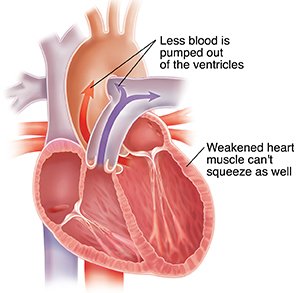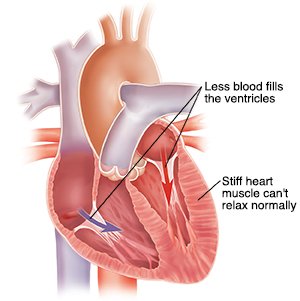Heart Failure
With heart failure, not enough oxygen-rich blood leaves the heart with each beat. There are 2 types of heart failure. Both affect how well the left ventricles can pump blood. You may have one or both types.

Systolic heart failure. The heart muscle becomes weak and enlarged. It can’t pump enough oxygen-rich blood forward to the rest of the body when the ventricles contract. The measurement of how much blood your heart pumps out with each beat is called ejection fraction. In systolic heart failure, the ejection fraction is lower than normal. This can cause blood to back up into the lungs and cause shortness of breath and eventually ankle swelling (edema). This is also called heart failure with reduce ejection fraction, or HFrEF.

Diastolic heart failure. The heart muscle becomes stiff. It doesn’t relax normally between contractions. This keeps the ventricles from filling with blood as they should. Ejection fraction is often in the normal range. This can still lead to the backup of blood into the body and affect the organs such as the liver. This is also called heart failure with preserved ejection fraction, or HFpEF.
Recognizing heart failure symptoms
When you have heart failure, you need to pay close attention to your body and how you feel, every single day. That way, if a problem occurs, you can get help before it becomes too severe. You’ll need to watch for changes in your symptoms. As long as symptoms stay about the same from one day to the next, your heart failure is stable. But if symptoms start to get worse, it’s time to take action.
For more information on this topic, visit our Health Library.
